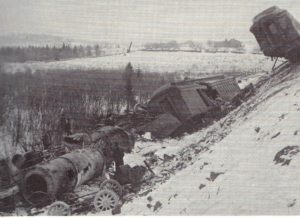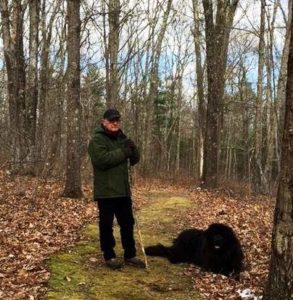Sullivan County Historian John Conway admits he loves history. He also loves to hike, so it was probably inevitable that he would eventually begin to offer a unique opportunity for local residents to join him in enjoying both endeavors at once. He calls the events “History Hikes” and, weather permitting, he will be hosting one in Hurleyville on Saturday, February 11. It is the first of a series of hikes he hopes to host at various locations throughout 2017.

The Hurleyville History Hike, held in collaboration with the Fallsburg Parks Department, will take place beginning at 2 PM at the Milk Train Rail Trail just off Main Street and will commemorate the tragic 1907 O&W Railroad accident that occurred about a half a mile south of what is now the trail head.
The story of the accident is one Mr. Conway has related before, but this will be the first time he will do so while actually visiting the scene of the tragedy.
“Late in the afternoon of February 13, 1907 the boiler exploded on an O&W passenger train just before it reached Luzon Station in Hurleyville,” he says. “Two railroad men were killed instantly in the explosion, the train’s engineer was severely injured and would die a few days later, and twelve passengers were hurt when the train careened off the tracks.”
Mr. Conway says the force of the blast sent pieces of the train and the bodies of the dead crew members hurtling through the air, some landing hundreds of feet from the scene.
According to contemporary newspaper accounts, the engine was drawing the No. 3 train, “one of the finest on the road” and was doing about forty miles per hour when “suddenly there was a terrible roar and the sound of ripping and tearing of iron. The train of cars rammed the wreck and four of them left the rails. When the steam cleared, there was nothing but scrap iron left of the locomotive.”
The train had originated in Weehawken, N.J. around noon that day, heading for the mountains with about fifty passengers. It had pulled out of Middletown about 3 PM and had just emerged from the rock cut known as Smith’s Cut when the explosion occurred. The train was within sight of the station at the time, and some accounts of the day noted that passengers waiting for the train had seen it approaching in the distance and then watched in horror as it was engulfed in smoke and steam.
Mr. Conway notes that some people at the time had suspected that dynamite had caused the explosion, and stories circulated that either intentionally or by accident the dynamite had been mixed in with the coal that was being used to feed the boiler. The railroad eventually debunked that theory and suggested instead that the water lines feeding the boiler had frozen, causing the boiler to run low on water and to overheat. That overheating then thawed the lines, allowing cold water into the boiler and causing the explosion.
The body of the train’s engineer, William Gadwood of Walton, NY, was discovered more than 100 feet from the wreck. Mr. Gadwood was alive but severely injured when found, his skull fractured in several places, and he died shortly afterward. The mangled body of fireman Martin Mullen, who was believed to have been killed instantly in the explosion, was found 100 feet in the opposite direction. A third man, later identified as O&W employee J.D. Vulquette, was also killed in the explosion.
The History Hike will start from the trail head by the basketball courts and continue south to the rock cut and then back again, with Mr. Conway narrating the story of the wreck and relating other historical tidbits about Hurleyville and the railroad along the way.

He says it is an opportunity for folks who love history or railroads to learn about an incident that was once well known, but the details of which have been lost to time.
In fact, just last year, Mr. Conway began an effort to memorialize the wreck with an interpretive sign not far from the scene of the explosion.
He says that now that the old railroad bed is part of the Milk Train Rail Trail and will be regularly visited by hikers and bikers, there is an opportunity to chronicle a bit of history, so he is spearheading the project along with Fallsburg Town Historian Isaac “Yits” Kantrowitz.
“The incident is something that should be memorialized, and a small group of us are working on getting a sign erected on the rail trail that tells the story of the explosion and something of the men who died in it,” Mr. Kantrowitz has said.
Mr. Conway and others have been studying newspaper stories and photographs in an attempt to get an accurate idea of where the wreck took place. The interpretive sign will be placed at the trail head just off Main Street and will indicate the distance down the trail to the spot of the wreck. A smaller marker will designate the actual location.
“We are envisioning a substantial sign on the trail near Main Street that will describe the incident and point out the location of the explosion down the tracks,” Mr. Kantrowitz said.
There is paving work that will take place on the trail beginning in the spring, so the erection of the sign will have to wait until that is completed. In the meantime, the best opportunity to learn about the explosion, as well as other bits of Hurleyville history, will come on February 11.
“People must sign up by e-mail to take part in the hike,” Mr. Conway says. “So they should contact me at jconway52@hotmail.com. The hike is weather dependent, so in the event of a cancellation or postponement, I will notify those who are signed up by e-mail.”
